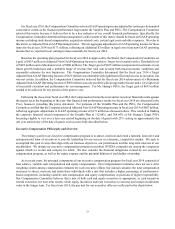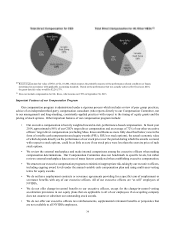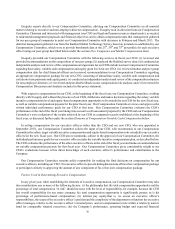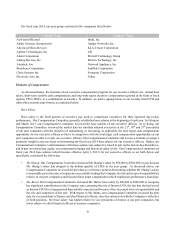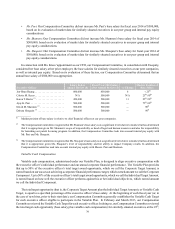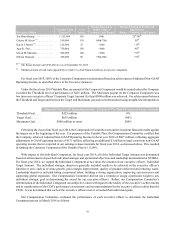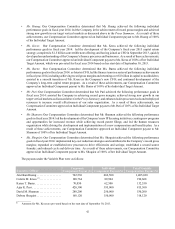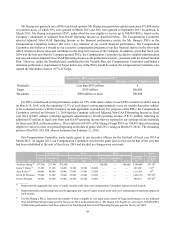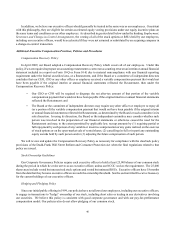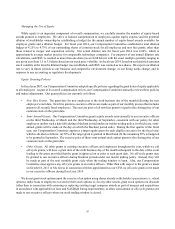NVIDIA 2013 Annual Report Download - page 55
Download and view the complete annual report
Please find page 55 of the 2013 NVIDIA annual report below. You can navigate through the pages in the report by either clicking on the pages listed below, or by using the keyword search tool below to find specific information within the annual report.37
constraints; (iv) the trends in compensation paid to similarly situated officers at our peer companies; (v) the 25th, 50th and
75th percentiles of compensation paid to similarly situated executive officers at our peer companies; (vi) an executive officer’s
past performance and expected contribution to future results; (vii) the need to attract new talent to our executive team; (viii)
the ability to retain existing talent in a highly competitive industry; (ix) the need to motivate executive officers to address
particular business challenges that are unique to any given year; (x) the independent judgment of the members of our
Compensation Committee; (xi) our CEO’s recommendations, because of his direct knowledge of the results delivered and
leadership demonstrated by each executive officer; (xii) a review of an executive officer’s current total compensation; and
(xiii) the total compensation cost and stockholder dilution resulting from executive compensation actions, as we believe
this helps us maintain a responsible cost structure for our compensation programs. The relative weight, if any, given to
each of the factors above varies with each individual executive officer and with respect to each element of compensation
at the sole discretion of our Compensation Committee.
Peer Companies and Market Compensation Data
In late fiscal year 2013, Exequity and our human resources department recommended, and our Compensation Committee
approved, our peer companies for fiscal year 2014 which are companies that (i) we generally think we compete with for
executive talent, (ii) have an established business, market presence, and complexity similar to us, and (iii) are of similar
size to us as measured by revenue (at roughly 0.5-2.0x NVIDIA) and market capitalizations. Our peer group for fiscal year
2014 generally remained the same as it was for fiscal year 2013, except that (i) Maxim Integrated, Inc. was removed because
we no longer consider Maxim to be of similar size or complexity and we generally do not compete with Maxim for executive
talent, and (ii) Citrix Systems, Inc. was added because we consider Citrix to be of similar size and complexity and we believe
we generally compete with Citrix for executive talent. The median revenue and market capitalization for our peer group
was approximately $4.3 billion and $9.7 billion, respectively, which closely approximates our aggregate revenue of $4.3
billion for fiscal year 2013 and market capitalization of $7.1 billion in late fiscal year 2013.
Our Compensation Committee reviews market practices for compensating our desired talent pool, including data from
our peer group, for the three major components of our compensation program. When reviewing and analyzing the amount
of each major component and the total compensation opportunity for our executive officers, our Compensation Committee
reviews each component at the 25th, 50th and 75th percentile for our peer companies for guidance. Our Compensation
Committee reviews these pay levels as reference points in its overall decision making, as indicative of the level of
compensation necessary to attract, retain and motivate our executive officers.
Our Compensation Committee set the actual amount of each element of compensation and the total compensation
opportunity of each executive officer based in part on its review of peer group data and in part on the factors discussed
above under the section Factors Used in Determining Executive Compensation and below in respect of actual decisions for
fiscal year 2014.








